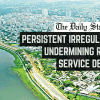Detailed Area Plan for Dhaka: Is a liveable and sustainable future too much to ask for?

It is a matter of pity that, with nearly 40 years of experience in planning, I have failed to find why many people are so enthusiastic about the new Detailed Area Plan (DAP) for Dhaka.
From what I understand, it is supposed to be a preparation in advance for what you should do with every inch of land in an unplanned area so that it meets the future needs. The law of the land requires that a "competent body" will prepare the (land-use) master plan for areas under its jurisdiction. That competent body for Dhaka is Rajdhani Unnayan Kartripakkha (Rajuk).
In 1997, it prepared a three-tier master plan consisting of a structure plan (DSP) and urban area plans (UAPs) for 19 zones, and left the DAP to be prepared by local consultants – which they did. In the DSP, we evaluate the previous plan, collect the latest data on the current situation and trends, set a vision, and decide on the policies. At the UAP level, we define the strategies to adopt for implementing said policies, and in the DAP at the ground level, we define the land use and transport network. Of course, a plan is not about all things physical; it also includes how to generate employment opportunities, mitigate adverse effects of climate change, make a healthy living, etc.
Note that DAP should follow decisions already set in the DSP and adopt the strategies set in UAPs. For example, say, the DSP takes the policy that no inter-district bus should ply through the city proper. In that case, the UAP may draw a thick, bent line along the edge in the city map to suggest bypass roads. The DAP should show the proposed road alignment in proper scale with feeder roads and/or exits. This is what is missing from the new DAP: actual plans or development schemes that define a future use of the unplanned areas.
Can a city as big as Dhaka have a DAP for its entire area? The answer is no. It should instead prepare detailed plans of the unplanned areas – only those that are mostly informal developments, newly claimed areas, gradually crystallising or expanding urban areas, fringe areas, and/or new satellite townships to be developed. In the new DAP, the DSP area has been divided into 18 central city sub-areas and eight expanding city sub-areas.
All of these burgeoning areas should have their own plans of permissible land uses and alignment (right of way) for all future roads. And for the central areas (presumably planned already), if there are major changes (due to violations or evolution or other reasons), they need to be addressed in DAP, either by validating changed uses, assigning new uses or suggesting corrective measures. For example, the 65-year-old Tejgaon industrial area has evolved into a mixed-use institutional-commercial area over the years, and is destined to change further. Thus, the new DAP should have taken cognisance of the fact and suggest a plan for the future use of the area. But DAP has virtually nothing for the area. It has validated all indiscriminate uses and left all unplanned informal uses of the areas surrounded by the industrial area and Hatirjheel at the mercy of those occupying them.
So what does the new DAP offer? The most controversial and highly contested of its policies is the idea of reducing density. As mentioned earlier, DAP is not supposed to make any policy decisions; it should only show what steps and schemes would be undertaken in order to achieve the policy targets outlined in the DSP by adopting the strategies listed in the UAP. DAP has violated this order, and overstepped its jurisdiction and scope. It often refers to a DSP 2016-35, which does not exist legally. Yet, this phantom structure plan is claimed to be guiding all decision-making at the DAP level.
DAP depicts a vision, but whose vision that is and how it came to be are not clear. It is certainly not the people's, because we definitely did not participate in this exercise. The vision of a city has to be generated with full participation of all stakeholders, the supreme of which is the citizens. The latest DAP also includes some objectives. Visions and objectives should all have been set at the upper level plan, not here. Even if we accept that we list the objectives in order to clarify the proposals' perspectives, I would say DAP objectives are haphazard. Housing regeneration should have been the first objective, if at all, not the last. I fail to understand how freedom of investment could be Objective Number One, which actually absolves the government of its responsibilities.
Dhaka has consistently remained at the bottom of the liveability and pollution indices. Add to that the looming threat of climate migration and our commitment to the SDGs. The new DAP will certainly not meet almost any of the SDGs. In our existential crisis created by severe climate, bad governance, inadequate infrastructure, unabated traffic and urbanisation, and homelessness, DAP is going to be the last nail.
DAP is not the panacea of all ills. But, can we, the citizens of Dhaka, not demand a just, equitable, liveable and sustainable future?
Prof Mohammed Mahbubur Rahman is the pro-vice-chancellor of Ahsanullah University of Science and Technology (AUST).

 For all latest news, follow The Daily Star's Google News channel.
For all latest news, follow The Daily Star's Google News channel. 












Comments